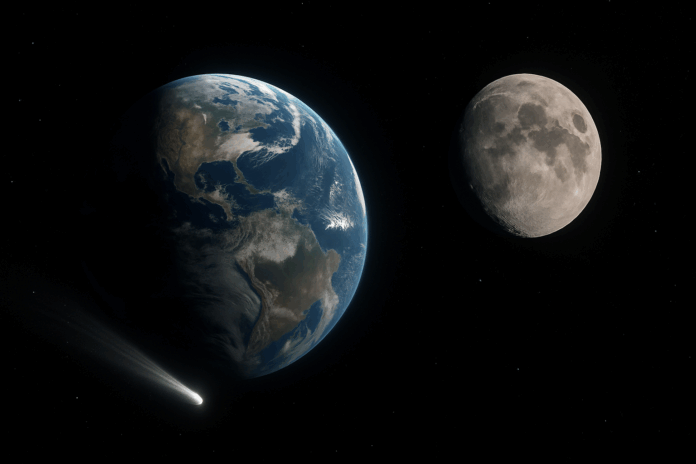Opening Moment
- A visitor from another star system that can speed up, slow down, and defy standard comet physics has now entered the most closely watched phase of its journey.
- Its erratic changes in acceleration have sparked a question that was unthinkable just a year ago: could 3I/ATLAS anchor itself into a long-term orbital rhythm with Earth?
- Recent discoveries in our own cosmic neighborhood suggest this possibility is no longer science fiction.
By Samuel Lopez | USA Herald
Today, as NASA prepares to unveil its newest images and data during a highly anticipated live event, researchers around the world are quietly re-evaluating the trajectory of 3I/ATLAS. This object has already demonstrated behavior that no natural comet should be capable of performing with such precision.
It accelerated when no outgassing was detected. It slowed down under conditions that made no thermodynamic sense. And its overall motion has shown a degree of control that continues to challenge every conventional model.
These are not subtle deviations. They are the kinds of changes that, in orbital mechanics, can alter the relationship between an object and the bodies it passes near. And that is why the latest discovery of Earth’s newest “traveling companion” has suddenly become relevant to the 3I/ATLAS conversation.
In September 2025, astronomers confirmed that Earth has picked up a new quasi-moon: asteroid 2025 PN7, a tiny object only about 62 feet wide, now moving through space in near-perfect step with our planet.
Its orbit mirrors Earth’s with such closeness that it will remain with us until roughly 2083, drifting ahead and behind us in a stable, decades-long cosmic dance. It is not gravitationally captured in the way our Moon is, but it is clearly locked into a synchronized orbital rhythm that allows it to remain nearby for nearly sixty years.
This simple fact—this proof of concept—changes the conversation about 3I/ATLAS. If a natural object can casually slip into Earth’s orbital lane and stay there for generations, then the question becomes obvious: what happens when the visiting object in question is one that has already shown the ability to change its speed, alter its direction, and behave like it has access to its own propulsion?
I am not suggesting 3I/ATLAS will suddenly drop into a traditional orbit around Earth. That would require an enormous loss of velocity and a descent into the narrow region where our gravitational pull dominates. But that is not the scenario scientists are considering. The more realistic question is whether 3I/ATLAS could fall into a co-orbital relationship similar to Arjuna 2025 PN7 or Earth’s other quasi-moons.
In such a scenario, 3I/ATLAS would not become a moon at all but rather a long-term companion—an object that takes roughly the same path around the Sun as we do, moving in a stable pattern that keeps it within observational range for years or even decades.
This possibility becomes even more intriguing when we consider its known anomalies. The acceleration shifts. The braking maneuvers. The jet orientation that refuses to smear with rotation. The sunward anti-tail. The absorption of OH maser frequencies associated with the chemistry of life. Each of these suggests that 3I/ATLAS is operating under forces that cannot be easily explained by traditional comet behavior.
And objects that can control their own momentum, even slightly, simply do not behave like passive rocks drifting through space. They make choices, whether natural or technological.
If 3I/ATLAS “chooses” to alter its acceleration during its December 19 closest approach to Earth, the door opens to a scenario where it could settle into a long-term dynamic relationship with our planet’s orbit. There is no rule of physics preventing this. There is only probability—and that probability is no longer zero.
The implications would be profound. Scientifically, it would mark the first time an interstellar object has ever taken up a stable orbital position in our solar system. Strategically, it would raise immediate questions for national security, given the object’s unexplained maneuvers. Historically, it would become one of the most significant events since humanity first set foot on the Moon.
Whether NASA addresses this today remains to be seen. But the acceleration profile of 3I/ATLAS is already rewriting the boundaries of what interstellar objects can do.
I will be reporting on NASA’s live event in real time. Follow me on X at @RealUSAHerald for immediate analysis as new images and data are released.
Stay with USA Herald for continuing coverage as we witness what may become one of the defining scientific moments of our lifetime.



